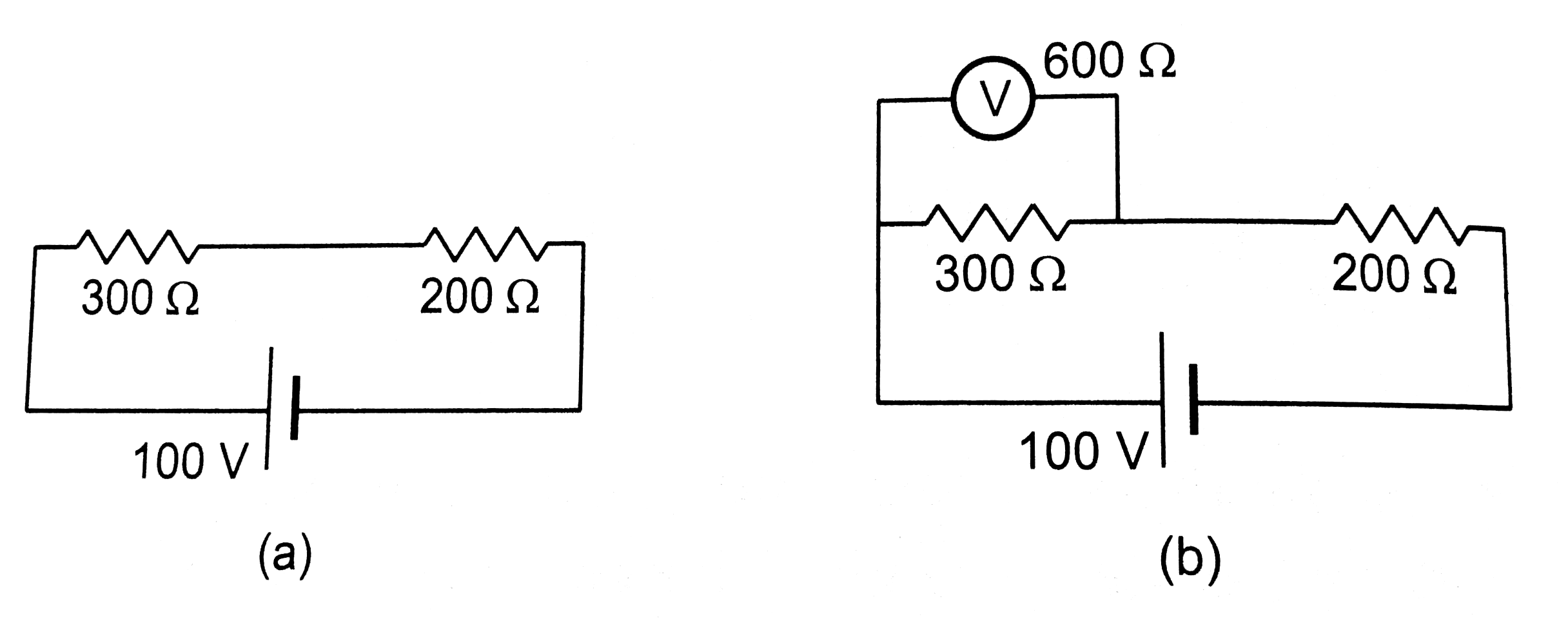To measure a potential difference across a resistor of resistance RS, a voltmeter of resistance Ry is used. To measure the potential with a minimum accuracy of 95%, then
Rv=5R
Rv=15R
Rv=10R
Rv,≥19R
The correct Answer is:D
To solve the problem of measuring the potential difference across a resistor RS using a voltmeter of resistance RY with a minimum accuracy of 95%, we can follow these steps:
Step 1: Understand the Circuit Configuration
The voltmeter is connected in parallel with the resistor RS. This means that the voltage across the resistor RS (denoted as V0) is the same as the voltage across the voltmeter (denoted as V).
Step 2: Write the Expression for Voltage
The voltage across the resistor RS when a current I flows through it is given by:
V0=I⋅RS
Step 3: Determine the Voltage Reading of the Voltmeter
Since the voltmeter is in parallel with RS, the effective resistance Req of the parallel combination of RS and RY can be calculated using the formula:
Req=RS⋅RYRS+RY
The voltage reading V across the voltmeter can be expressed as:
V=I⋅Req=I⋅RS⋅RYRS+RY
Step 4: Set Up the Accuracy Condition
To achieve a minimum accuracy of 95%, the reading V must be at least 95% of the actual voltage V0:
V≥0.95⋅V0
Substituting the expressions for V and V0:
I⋅RS⋅RYRS+RY≥0.95⋅(I⋅RS)
We can cancel I from both sides (assuming I≠0):
RS⋅RYRS+RY≥0.95⋅RS
Step 5: Rearranging the Inequality
Rearranging the inequality gives:
RS⋅RY≥0.95⋅RS⋅(RS+RY)
Expanding the right side:
RS⋅RY≥0.95⋅R2S+0.95⋅RS⋅RY
Rearranging terms:
RS⋅RY−0.95⋅RS⋅RY≥0.95⋅R2S
Factoring out RY:
(1−0.95)RS⋅RY≥0.95⋅R2S
This simplifies to:
0.05⋅RS⋅RY≥0.95⋅R2S
Dividing both sides by 0.05⋅RS (assuming RS≠0):
RY≥19⋅RS
Conclusion
Thus, for the voltmeter resistance RY to ensure a minimum accuracy of 95%, it must satisfy the condition:
RY≥19⋅RS
The voltmeter is connected in parallel with the resistor RS. This means that the voltage across the resistor RS (denoted as V0) is the same as the voltage across the voltmeter (denoted as V).
The voltage across the resistor RS when a current I flows through it is given by:
V0=I⋅RS
Since the voltmeter is in parallel with RS, the effective resistance Req of the parallel combination of RS and RY can be calculated using the formula:
Req=RS⋅RYRS+RY
The voltage reading V across the voltmeter can be expressed as:
V=I⋅Req=I⋅RS⋅RYRS+RY
To achieve a minimum accuracy of 95%, the reading V must be at least 95% of the actual voltage V0:
V≥0.95⋅V0
Substituting the expressions for V and V0:
I⋅RS⋅RYRS+RY≥0.95⋅(I⋅RS)
We can cancel I from both sides (assuming I≠0):
RS⋅RYRS+RY≥0.95⋅RS
Rearranging the inequality gives:
RS⋅RY≥0.95⋅RS⋅(RS+RY)
Expanding the right side:
RS⋅RY≥0.95⋅R2S+0.95⋅RS⋅RY
Rearranging terms:
RS⋅RY−0.95⋅RS⋅RY≥0.95⋅R2S
Factoring out RY:
(1−0.95)RS⋅RY≥0.95⋅R2S
This simplifies to:
0.05⋅RS⋅RY≥0.95⋅R2S
Dividing both sides by 0.05⋅RS (assuming RS≠0):
RY≥19⋅RS
Thus, for the voltmeter resistance RY to ensure a minimum accuracy of 95%, it must satisfy the condition:
RY≥19⋅RS
Topper's Solved these Questions
- BOOK - FIITJEECHAPTER - CURRENT ELECTRICITYEXERCISE - ASSIGNMENT PROBLEMS (OBJECTIVE)(Level-II)20videos
CURRENT ELECTRICITY
- BOOK - FIITJEECHAPTER - CURRENT ELECTRICITYEXERCISE - Comprehension -(1)5videos
CURRENT ELECTRICITY
- BOOK - FIITJEECHAPTER - CURRENT ELECTRICITYEXERCISE - ASSIGNMENT PROBLEMS (SUBJECTIVE)(Level-II//III)14videos
CURRENT ELECTRICITY
- BOOK - FIITJEECHAPTER - COLLISION EXERCISE - (NUMERICAL BASED QUESTIONS)4videos
COLLISION
- BOOK - FIITJEECHAPTER - ELASTICITY AND WAVES EXERCISE - Assignment Problems (Objective) Level-II15videos
ELASTICITY AND WAVES
Similar Questions
(a)find the potential drops across the two resistors shown in figure. (b) A voltmeter of resistance (600Ω)is used to measure the potential drop across the (300Ω) resistor.What will be the measured potential drop?
 View Solution
View SolutionPotentiometer measures the potential difference more accurately than a voltmeter, because
View Solution
Knowledge Check
- Question 1 - Select One
Potentiometer is superior to voltmeter because
AUses a long wireBWorks on the principle of wheatstone bridgeCDoes not disturb the potential difference under measurementDUses a battery of larger emf in the main circuit - Question 2 - Select One
For the measurement of potential difference, voltmeter is connected
Ain parallel with the circuitBin open circuitCin series with the circuitDbeyond the circuit - Question 3 - Select One
____instrument is used to measure potential difference
APotentiometerBAmmeterCGalvanometerDVoltmeter
A moving coil voltmeter is generally used to measure the potential difference across a conductor of resistance 'r' carrying a current i. The resistance of voltmeter is R. For more correct measurement of potential difference
View SolutionA moving coil voltmeter is generally used to measure the potential difference across a conductor of resistance 'r' carrying a current i. The resistance of voltmeter is R. For more correct measurement of potential difference
View SolutionA moving coil voltmeter is generally used to measure the potential difference across a conductor of resistance 'r' carrying a current i. The resistance of voltmeter is R. For more correct measurement of potential difference
View SolutionTo measure the current and potential difference of the resistances connected in series in a circuit, we will use
View SolutionTo measure the current and potential difference of the resistances connected in series in a circuit, we will use
View Solution

